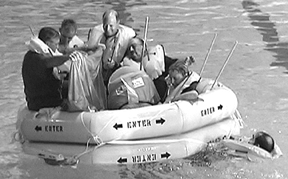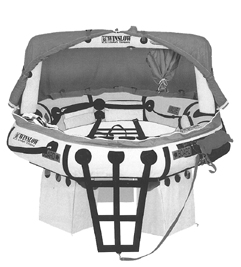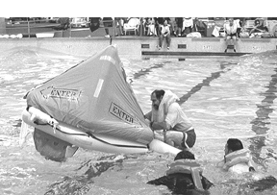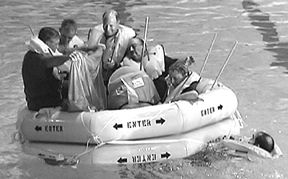
Since we last examined aviation life rafts four years ago, new designs have been introduced and weve seen significant improvements made to existing products. Light aircraft owners have benefited from the Part 135 and big-iron GA market, which drives raft development, for better or worse.
We were sent evaluation rafts from Air Cruisers, BFGoodrich, Hoover and Winslow. Once again, Eastern Aero Marine (EAM) and Survival Products declined to participate and RFD didnt return our calls or e-mails. Survival Products later had an apparent change of heart and did provide rafts for testing.
Our testing protocol was simple but demanding. We enlisted a team of volunteers-ranging from raft virgins to experienced survival experts-to try each product in a wave pool capable of generating a simulated seaway. To test canopies, we used a firehose stream directed at the rafts.
Air Cruisers Company
Air Cruisers, new to the GA market, have been making rafts and slide rafts for transports for years. They sent a four-person and a 13-person double -tube TSOd raft. The smaller is hexagonal while the bigger one is round.
The effort to reduce weight on these rafts was obvious, sometimes painfully so. We were surprised by Air Cruisers Al Wigerts explanation that the priority was reduced weight, followed by price.
When we asked where performance stood, he told us it came last, a view in line with the aircraft manufacturers (not crews) who are the primary raft customers.
Both rafts have a single-arch canopy, but neither stayed erect when we failed the upper tube. Except for under the arch, both were deemed uncomfortable, although the 13-person was much better because the large 12-inch tubes and its larger diameter gives better geometry.
The rafts have a thin closed-cell foam floor for insulation that proved unable to take even the minimal abuse of our short test before being ripped up.
An inflatable ramp-style entry aid, attached between tubes on the smaller raft, on the bottom tube on the larger, proved a mixed bag for testers. While some praised it, others had difficulties. Heavier persons in particular had problems as the ramp collapsed under them.
Some found it impossible to board over the high-freeboard double tubes of the 13-person without assistance, even with the lightweight inside boarding ladder to help. The four-person, with only 8-inch tubes, has a one-inch webbing line running across the raft with loops attached that proved difficult to grasp.
The lightweight zippers on both canopy entry flaps failed on the 13-person and one of the zippers on the four-person jammed, rendering the canopy useless.
The raft knife on the 13-person raft wouldnt reach the mooring/inflation line, the tether was 48 inches too short and the fitting on the manual inflation pump didnt match the rafts topping valves, rendering the pump useless. The attached cap on the recessed valves made use of the correct pump, in the four-person, difficult.
The four-person has a trio of narrow tapered ballast bags, the 13-person is fitted with four, but their weight (195 and 260 pounds total) is inadequate in our opinion. The large drogue (sea anchor) proved capable, but its line was too short.
The larger raft provided only 3.36 square feet per person, the only raft reviewed that didnt meet the minimal standard of 3.6 square feet called out in the TSO. Air Cruiser claims compliance via an allowed alternative method, but we think the raft is too small.
The survival equipment pack is on a tether and must be retrieved from the water, which isn’t immediately obvious due to poor placarding. We found a number of food packages ruptured or damaged, apparently in packing the raft, and the food already spoiled in one instance.
The 13-person raft was vacuum packed, an option ($300) when space is at a premium and a feature we like for the added protection it offers. Disputed Service Interval
One of Air Cruisers big selling points has been that these rafts only need to be serviced every six years, compared to the industry standard of one year. However, it turns out that this isn’t the entire story.
Because they use a composite-wound inflation cylinder, it must be hydro-tested every three years. Air Cruisers explained that while the raft valise must indeed be opened and the cylinder removed for testing, the raft itself doesnt need servicing.
While Air Cruisers may be comfortable performing this procedure, two respected stations we checked with wanted nothing to do with it. That may change as experience is gained with these new products. But be warned you may have to send your raft to Air Cruisers for service. In any case, thats still a year longer than anyone else in the industry, two more than most.
Air Cruisers also claims that the PUR Survivor 06 Manual Reverse Osmosis Desalinator in the Part 135 SEP requires service every three years and has a letter from PUR that can be interpreted to support that claim. However, we contacted PUR and were told two years is the maximum recommended service interval for civil aviation use.
Moreover, PUR advised us that an extended service interval is more likely to require the replacement of expensive components, significantly increasing the cost of service.
Bottom line: During the claimed six-year service interval, the pack would actually need to be opened at two, three and four years for service. Air Cruisers maintains their three-year service schedule is acceptable and is not altering it.
BFGoodrich
BFGoodrich sent both a four-person and a 12-person approved raft. Both rafts incorporate BFGs unique boarding platform, a swath of fabric slung between two inflatable outriggers sticking out from the side of the rafts bottom tube, one on the four-person, a nearly round raft, one on either end of the 12-person, a long rectangle with round ends.
A number of one-inch webbing grab handles and a lightweight interior boarding ladder are also provided. They appear to have shortened up the platform since our last test.
Combined with the ladder and the relatively low 18-inch total depth, our testers found it worked better; boarding was easy for the most part. The smaller raft has only a single-arch canopy, which elicited negative comments.
The 12-person is equipped with a unique canopy support system, a pair of hoops at either end of the straight sections, joined by a central tube. This provides the most spacious headroom of all the rafts we tested.
Large zippers make closing the rafts easy, but lack of adequate storm flaps meant they leaked in our simulated storm conditions. BFGs four small ballast bags (196 pounds total) are inadequate and five drain holes make them even less effective, in our view. Moreover, the drogue attach point failed on the 12-person, which could be disastrous in heavy seas, in our view, allowing the long raft to broach and easily capsize given the inadequate ballast.
According to BFG, analysis showed the failure was the result of substandard bonding, an assembly error. While the drogue is an important contributor to stability, for a boat-shaped raft, the sea anchor is essential. The rafts are available in sizes for four, eight, 10 and 12 persons.
Hoover Industries
Hoover provided one of its new FR-6, six-person reversible (meaning it has no top or bottom) rafts, although in a bizarre twist, they declined to provide pricing for the raft supplied.
Our volunteer testers struggled to board the raft via the two-rung boarding ladder with only a couple hand holds to assist. It proved impossible for one of the volunteers to board unassisted as the raft flipped as she tried to climb aboard. The floor is slung between the two tubes, sagging considerably, providing a sloping floor that made it difficult to maintain a sitting position at the tube. The four token ballast bags (80 pounds total) and rudimentary drogue are ineffective, in our view.

The canopy was a puzzle that took nearly a half-hour to erect and even then it wasnt entirely correct. The central aluminum mast poked holes in the floor. When the raft was capsized, very easily as you might expect, the ensuing jumble of rods made for a potentially lethal situation under the raft and a number of the canopy support rods were bent, making re-erection more difficult. The canopy proved no match for the fire hose rain test. The survival equipment pack is tethered to the raft and had to be retrieved from where it was trapped underneath. (Poor placarding didnt help.) We had to empty virtually the entire contents, risking their loss, to get to the canopy.
Hoover continues to use old-fashioned topping valves, and true to form, one was closed so tightly during the testing that it proved impossible to open without mechanical assistance, which was not provided.
Survival Products, Inc.
We obtained samples of both of Survival Products new offerings, a four-person single-tube, double-cell raft and a six-person double-tube raft, representing the first FAA-approved rafts manufactured by the company.
They have since also certified an eight-person and 10-person of the same designs. The single-tube raft is not significantly different in design from the original square single-cell model, although added bulkheads and an improved inflation mechanism give it dual-chamber capability.
We didnt much care for the combination topping and pressure relief valves, mostly because they are located inside the canopy, once you erect it. A plastic tab and loop system to secure the bottom made that task both easier and quicker. You still have to manually tie down and orally inflate the center mast so we don’t agree that its self-inflating, unless the self is you. The mil-spec oral inflation valve stymied many testers.
The teepee-style canopy (the rafts are available in unapproved form sans canopy and SEP) is essentially unchanged and is still uncomfortable. It collapsed and leaked copious quantities of water through the Velcro entry and under the sides in our simulated storm test, then tore at the mast attachment when the raft was capsized.
No retro-reflective material is used on the raft or canopy and placarding was poor. Escaping the canopy with the raft capsized proved difficult and frightening for some. Located under the center of the single-tube raft is a single large ballast bag (121 pounds) with a flap valve in the bottom to hasten filling. It proved minimally effective at preventing the raft from flipping during the boarding tests and is otherwise inadequate to resist capsizing.
The raft shipped a lot of water during boarding over its minimal 11-inch tube. The valise continues to serve as the drogue, doing a reasonably good job until its Velcro seams to catch on each other under surging conditions, reducing its drag and rendering it ineffective.
Give SPI credit for creative thinking in their pursuit of smaller and lighter. The quoit for the heaving line is a fabric tube filled with polymer granules that expand when immersed. The resulting sausage-like loop would be less capable in a real rescue and one split its seam, spilling hundreds of sticky, jelly-like polymer globules over the interior of the raft, rendering the heaving line useless and driving us crazy.
The double-tube raft is similar in most respects. There are two ballast bags on opposite sides of the raft at the entry points that served minimally for boarding purposes, but are otherwise inadequate. Boarding aids consist of a single loop of one-inch webbing for a step, the lifelines, and a grab handle on the upper tube, making boarding over the double 9.5-inch tubes difficult at best and impossible for some unassisted. As with the single-tube raft, capsizing was a cinch. The valise-cum drogue got caught up on its Velcro immediately almost every time we tried it and was nearly impossible to keep functioning.
Winslow LifeRaft Company
Winslow sent us prototypes of their revised aviation raft lineup, now in production. Winslows unapproved GAST Island Flyer is an octagonal, dual-cell, self-erecting single-arch canopy design, an improved version of the one we tested previously.
Three large ballast bags (384 pounds total) made for a relatively difficult-to-capsize four-person raft (also available in two-, six- and eight-person size). The GASTs entry aids feature a three-rung, center supported ladder, a tube-mounted grab handle, and an interior-assist ladder, all of easily grasped two-inch webbing. Together these made entry over the high-freeboard 13-inch tube relatively easy.
The GAST lacks headroom except under the arch, however its superior to anything else in its class in terms of weather tightness. Hardly a drop came through the upgraded storm flaps on the zippers. One popular feature was the viewing ports placed in the canopy, a potential antidote to seasickness.
On all the Winslow rafts, the immediate action instructions hanging from the arch are bold text on bright yellow stock, impossible to miss. They were also deemed the most complete and easiest to understand.
Winslow mounts a Pelican Products Magnum flashlight with lithium batteries on the arch leg in plain view for immediate access, which makes a great deal of sense to us. A unique righting locator light situated under the raft guides survivors to the righting location at night and provides minimal illumination to see the righting instructions and aids.

Winslow has also added retro-reflective material to the bottom of the raft, as required by the latest marine life raft regulations. Our raft was fitted with the standard, pretty comprehensive, General Aviation SEP and the optional ($200) inflatable floor.
The four- and 12-person approved FASL Super-Light Ultima rafts are improved versions of the top-rated FA-AV we previously reviewed. These decagonal double-tube rafts have an auto-erecting, stay-erect tri-arch canopy that provided adequate headroom over most of the interior except at the center of the entry.
Winslows entry aids, as described above, are supplemented on the double-tube rafts with a longer ladder, additional grab handles and stirrups on the bottom tube, resulting in a raft everyone could board with minimal difficulty, despite the enormous freeboard.
Winslows Pentagonal ballast system (415 pounds total) remains the most effective on any aviation raft, by a large margin. A larger ballast system is an available option.
Winslow also sent us a four- and a 12-person FAUL Ultra-Light. These are evolutions, or perhaps we should say devolutions, of the Ultima. With the big iron manufacturers insisting on lighter weight rafts, Winslow made compromises to save weight where they would least affect survivability while retaining the features of the Ultima the pilots and crew told us were most important to them, claimed Winslows Gerard Pickhardt.
Among other alterations, the canopy material was changed from the heavier dual-color material to the industry standard semi-transparent orange ripstop nylon and the buoyancy tubes were made smaller, reducing freeboard and reserve freeboard significantly, a notable reduction in overall capability.
That had the salutary side effect of increasing interior space. In all other respects the rafts remain the same. The UL does flex more in waves than the very rigid Ultima due to the smaller tubes.
Those highly regarded view ports are an available option on the approved rafts, we’ll worth the $450 in our opinion. Both TSOd rafts are available in 2- through 13-person sizes by single increments and beginning in May now have a two-year service interval for the initial four years, yearly thereafter.
Conclusions
We planned to test raft fabrics to settle some of the conflicting claims made by the manufacturers. Winslow supplied samples of their neoprene fabric, but both Air Cruisers and BFG, the only companies using polyurethane, declined. Both Wigert and Leibert Danielson, BFGs Director of Engineering, expressed concerns that consumers would not be able to make value judgements regarding the relative importance of the materials performance in our tests versus the light weight of their rafts.
With Survival Products you get what you pay for noted one tester. These rafts meet the letter of the regulations and if that is your sole concern, theyre the least expensive way to get an approved raft.
While the canopy isn’t good, in our view, at least it wont poke your eye out when the raft capsizes and its much quicker to set up. All other things being equally bad, the lower weight and price gets the nod, they are the best of the low-end, in our opinion.
The base single-tube raft, sans canopy and SEP, is an affordable option for those traveling over warmer waters in good weather and within range of quick rescue. The dual chambers are a plus over the single-cell unapproved sibling and the $330 additional is worth it in our opinion.
The Winslow RescueRaft II, also previously reviewed, is a better raft in many respects, higher quality, better entry aids and more freeboard, but not significantly more seaworthy and a lot more money, unless you can pick one up at a show special price.
The Survival Products Type I raft, supposedly for use under more challenging conditions, is a bust. Unseaworthy, in our opinion, it would be a poor choice for any serious overwater flying.
Aside from seaworthiness issues, if you cant get into the raft, it doesnt do much good.
For a company that has developed some truly innovative life vests, its hard to fathom why Hoover would introduce a new raft based on obsolete technology-except to compete with EAMs equivalent antiquated product. One volunteer summed up the consensus opinion, save yourself, forget the raft. We consider the Hoover among the least desirable approved rafts weve ever tested.
Air Cruisers rafts were a disappointment; we expected better. They appear to have thrown out the baby with the bath water in the quest for their Holy Grail of lighter weight and low cost. Asked one tester, what use is saving a few pounds if it wont save your life?
The canopy zipper failures are inexcusable, something that could be foreseen given the lightweight hardware. Again, some testers couldnt board, a serious failure, in our estimation.
Were not thrilled about the grossly extended service interval for the raft itself, irrespective of their representations regarding other services required.
On the marine side, we recently learned that a potentially life-threatening defect in one manufacturers rafts wasnt discovered for years solely because of extended service intervals. Given these and other shortcomings, we cannot recommend the Air Cruisers rafts.
BFG rafts remain a mixed bag. We like some of their features and theyve fixed beefs we had on our previous tests. The entry system proved effective, at least the equal and potentially better than Winslows. But were concerned about the lack of adequate ballast and the drogue failure was disturbing.
With hand-built products, its inevitable that assembly errors will occasionally occur, but construction quality has not been an issue with BFG in the past. The attachment point failure, combined with other less serious indications of poor quality control in the larger rafts construction, leave us wondering.
Neither BFGs or Air Cruisers inflatable boarding aids appear to meet the TSO standards requiring that a puncture not endanger the buoyancy tubes.
Obviously not content to rest on their laurels, Winslow continues to lead the industry in performance and features. Their overall quality, performance and consideration of human factors made a strong impression, as one tester noted, somebody actually thought about the people who might use this raft.
The improved GAST Island Flyer remains best in class and our choice for a capable single-tube general aviation raft, provided you don’t need it FAA approved.
While we wouldnt fly trans-oceanic with one, for most light aircraft use, its a good compromise and leads its class by a huge margin. The viewing ports are the best idea in life rafts since the self-erecting canopy.
The Winslow Ultima and Ultra-Light garnered every vote for best aviation raft from our volunteers. The aptly named Ultima is still Best Overall in our opinion, even better than last when we reviewed it. While not perfect, nothing else, except Winslows own Ultra-Light, comes close.
We were disappointed to see Winslow compromise its ultimate performance to produce the Ultra-Light, particularly the reduced freeboard. On the other hand, its a boon for safety conscious single and piston twin pilots where weight is generally a legitimate concern.
The Ultra-Light offers an increase in safety margin over the GAST without the weight penalty of the full-blown Ultima, making it a great compromise for those who prefer the extra margin and can afford the premium price.
Winslows move to a standard self-deploying 406 MHz beacon is a giant step forward; Itll get you rescued quicker than just about anything except ditching beside a Coast Guard cutter, and that, after all, is the ultimate goal.
In an industry that is always boasting about advanced safety equipment and uncompromising standards, we are perplexed by the biz-jet manufacturers who appear to be forcing the weight and cost issue without regard to resulting decreased safety margins.
One wonders if the worlds top executives and personalities signing the check realize the liberties being taken to allow those extra few bottles of wine on board?
by Douglas S. Ritter
Doug Ritter is a contributing editor to The Aviation Consumer and editor of Equipped To Survive (www.equipped.org).





